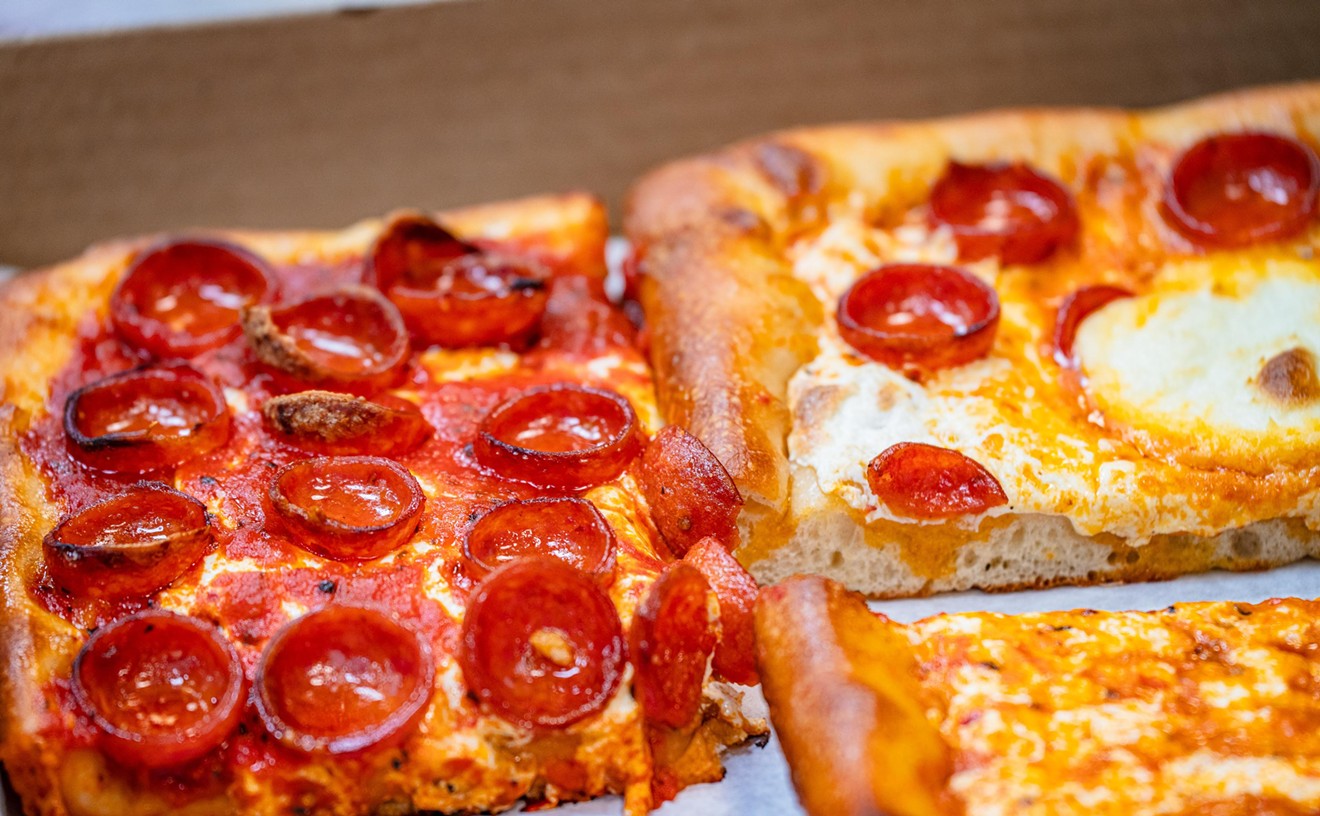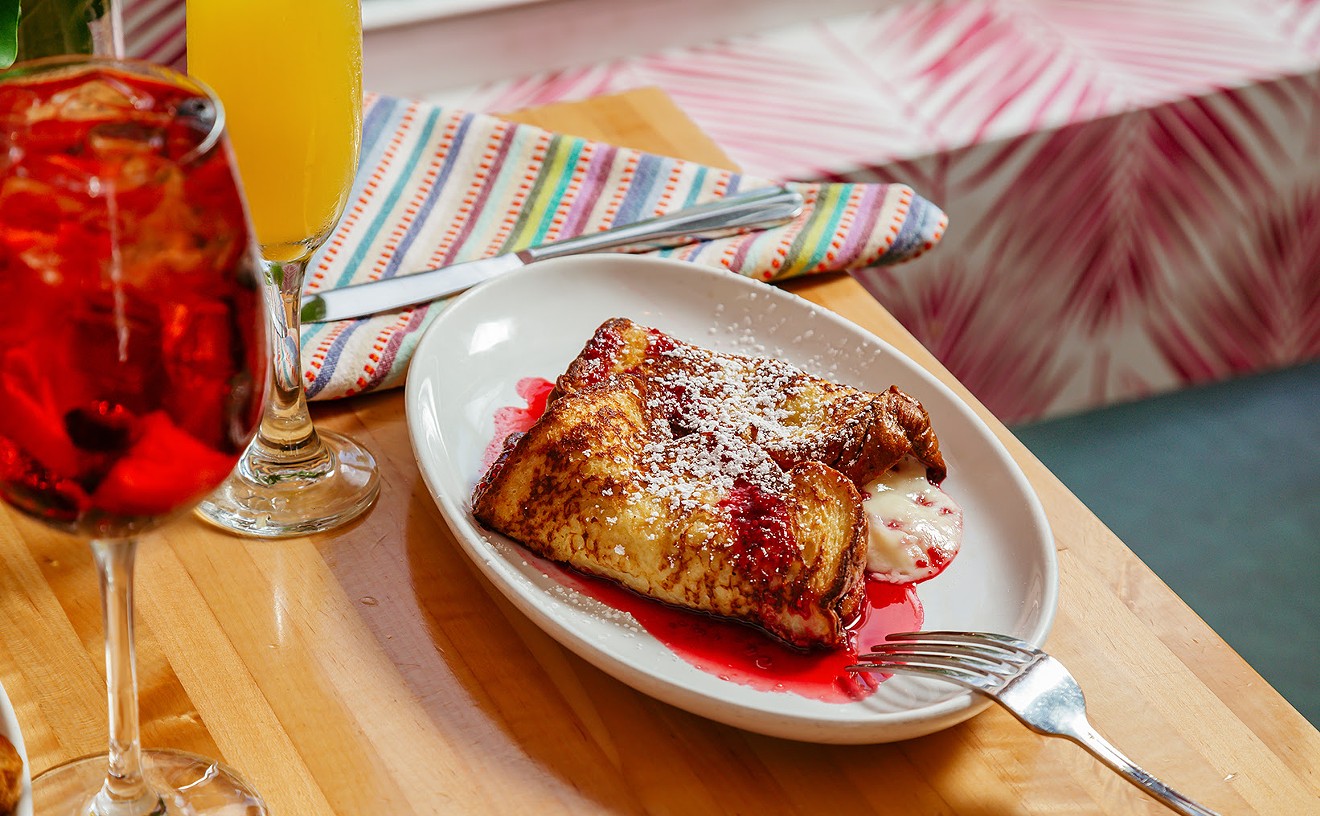Naturally, months after I moved from New York to Miami in 1993, Rodriguez moved from Miami to New York. Feh.
But finally, ten years later, he's back home, with OLA (Of Latin America). Well, sort of back. He's also still in N.Y.C. at Calle Ocho as well as the OLA he opened there last spring, in Philadelphia at Alma de Cuba, and in Arizona at Deseo. Actual on-premises chef de cuisine at Miami's OLA is Rick Gonzalez, a veteran of resort kitchens in Palm Beach, New York, and Aspen. The inspiration, though, is clearly Rodriguez's, as are some signature dishes locals will remember from Yuca. Most notable golden oldie: crispy pork, sinfully fatty meat served with its crackling and a mojo spiked with Cuban oregano to cut the grease, plus steamed yuca and vigoron (Nicaragua's citrusy, garlicky chicharrón-packed cabbage/cassava salad).
One difference between Manhattan's OLA and Miami's is that up north the above pork is listed in a section of the menu called "Pure Protein." Rodriguez, according to media reports, was himself on the Atkins diet when the original OLA opened, and a remarkably carbo-cut menu reflected the hefty chef's own April 2003 eating habits; a bowl of olives was even served in lieu of a breadbasket. Either Rodriguez has fallen off the megaprotein wagon or he's realized that such a dramatically starchless selection wouldn't go down as well in a real Latin American community, because Miami menu categories are simply appetizers, entrées, and ceviches.
It is still quite possible for Atkins dieters to pig out on pure protein and fat (though there is also less cheese-sauce overkill in Miami's selection -- thankfully). But to miss the yuca rolls passed out at the meal's start would be one of life's major mistakes. Our party was reduced to shamelessly waving our arms about and pointing at our mouths to attract the attention of OLA's bread dominatrix -- who really should know that just one of these soft, super-moist, savory biscuits could not possibly be enough. It was downright torture.
It's advisable to use the yuca rolls to sop up every last bit of the trompette de la mort vinaigrette dressing a watercress salad that accompanies a plate of several foie gras and fig empanadas; the highly aromatic flavor of the black "trumpet of death" mushrooms truly is to die for. The almond fig cake empanada wrap was a bit overthick for the foie gras pieces within, but the cake's nutty intensity was a nice foil for the buttery duck liver -- as were rich duck magret slices (like prosciutto but with a heftier, chewier texture) for the crunchy, bitter watercress.
Oysters Rockefeller with a Latin accent, Oysters Rodriguez, features the usual spinach but creamed and heated up with horseradish. The oysters, sizable and breaded, were deep-fried just enough so they were still firm rather than overcooked to mush. Under all was a bed of fufu, an originally African-Cuban favorite that's essentially a plantain/cassava mash; its natural sweetness was interesting against the oysters' brininess but was texturally a bit too heavy for their delicacy. And our table's noncarnivore was both disappointed that the dish contained big bacon chunks and justifiably annoyed that they hadn't been mentioned on the menu. A sauce of huacatay (black Peruvian mint) balanced the bacon's smokiness.
In between Yuca and opening his first New York spot, Patria, Rodriguez toured Latin America, accounting for the broadening of his cuisine from Nuevo Cuban to Nuevo Latino. OLA pushes the envelope even further, with influences from many Latin American nations plus accents from Spain and even Asia. All of this is reflected in the menu's ten ceviches; the ones we tried were elegantly "new style" -- only minimally vinegary due to brief marination rather than the old-fashioned, long pickling that preserves fish but puckers lips. Ecuadorian and Peruvian ceviches are generally considered the classics, and OLA Manhattan's purist ceviche is Peruvian style (featuring lime, chile, and onion), so Miami's most traditional shrimp ceviche has opted for Ecuador's typical addition of tomatoes, roasted to concentrate flavor. Though acid marinades do firm seafood, mackerel is a pretty impossible fish to firm up when it's not fresh, so the pleasant chewiness of the slices in lime-marinated mackerel ceviche, in lightly creamy horseradish sauce with crispy fried sage leaves, was reassuring. Ahi tuna ceviche combined Asia and Spain: a ginger/soy marinade and fresh seaweed, plus a sort of avocado foam. But the unusual combination of crisp-fried lemon rings, lemony aji amarillo pepper sauce, and pungent black olives made fluke ceviche my favorite.
For those who don't eat pork, vegetarian tacu tacu (a variety of baby vegetables in coconut curry, with sliced bananas) was a scrumptious and sizable entrée.
Desserts all sounded formidable. Best choice for those who've overindulged on dinner -- easy to do with so many interesting tastes -- is probably guava cheesecake, a silky-smooth slab topped with guava paste, and accompanied by crema nata ice cream as well as prunes poached in Grand Marnier. Better yet: an OLA mojito, with Limon rum instead of regular light rum and sugar cane juice in place of sugar, plus lime and mint -- not very potent, but tasty and refreshing.









